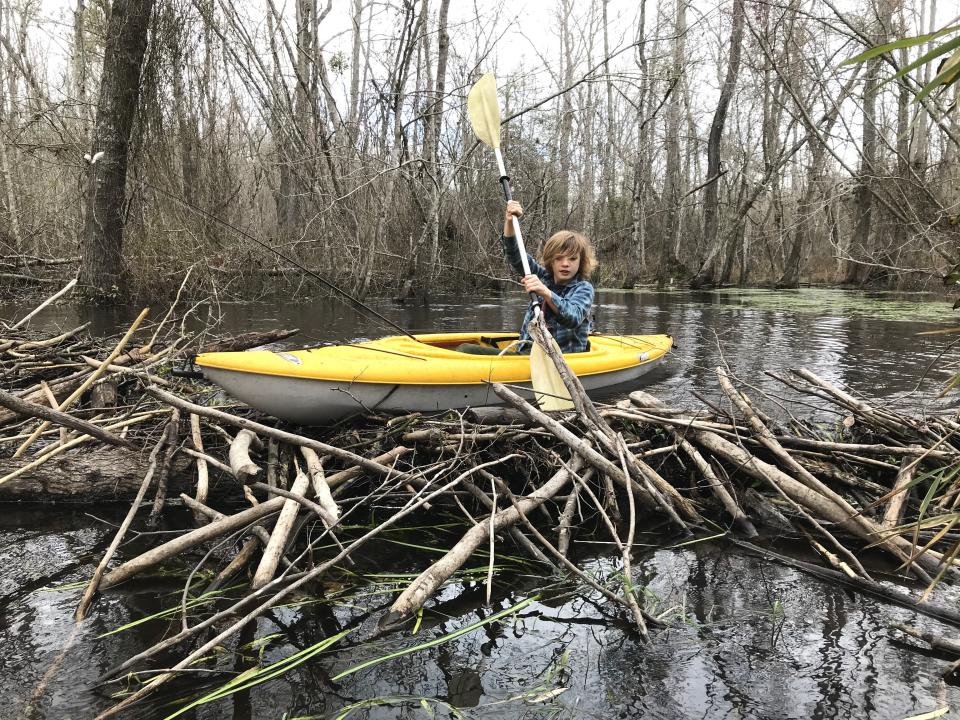How to decipher the clues nature leaves behind | ECOVIEWS
Want to enrich your wildlife experience on a warm spring day when birds, insects and plants abound? If you do, go on a spoor hunt.
According to the Oxford English Dictionary, “spoor” comes from a Dutch word that was first documented about a century ago. It means a “trace, track or trail of an animal.”
More: Frogs and snakes provide mysteries and adventures | ECOVIEWS
For example, a winding furrow of dead leaves in a forest, with occasional divots in the soil, is a sure sign an armadillo has been on the move. Softball-size holes high in a dead pine tree tell of a pileated woodpecker’s efforts to peck a nest hole. The chewed stump of a sweetgum next to a stream clearly indicates beaver activity.
To turn a spoor hunt into a classroom exercise, a teacher might ask students to make a list of 10 signs of animal activity. A bird nest, a spider web or a shiny snail trail would all qualify.

Although you may not be able to identify the architect, a chewed leaf or small round hole in the ground announces that an insect has paid a visit. In situations where cameras are permitted, you can document the presence of spoor with a photographic file.
Of course, spoor hunts do not have to involve a group. Anyone can take a solo trip and discover there is much more going on outside than they thought.
Sometimes even the simplest environmental clues can tell us something about wildlife in the world around us.
Among the commonest signs throughout North America (and identifiable by almost everybody) are the 5-toed footprints of a raccoon in snow or on a muddy creek bank. Learning the footprints of other denizens of field and forest, such as foxes, bobcats and rabbits, will enhance a spoor search.
Scat (animal droppings) can provide especially valuable environmental clues about an area’s unseen wildlife. How long has it been since the animal crossed your path? Do the contents contain fur, berries or scales denoting the presence of unseen plants or animals in the vicinity?
Any sign can be a gratifying wildlife experience to let us know we have company. We do not need to see, hear or smell the animal itself to discover evidence of its presence.
More: We have some oddities in our midst | ECOVIEWS
To take an even broader interpretation of spoor, consider the environmental tales chronicled by plants, often as a result of notable weather events. Trees offer visual proof of a storm’s passing long after the winds abate.
On Kiawah Island, several feet from the top of the tallest trees that survived the ravages of Hurricane Hugo in 1989, a faint bend toward the mainland can still be seen.
Trees that survive an ice storm may have visible imperfections more than a decade after their limbs were broken and bent. Charred bark at the base of an old oak tree tells of a long-ago forest fire. Even a benign clue, like grass glistening with droplets of water, lets you know that the predawn air cooled below the dewpoint. Environmental clues from animals and plants are constant and ubiquitous.

Wildlife biologists use sophisticated instrumentation and technology for all sorts of ecological studies.
Trail cameras can tell them what was where and when. Radio telemetry can tell them where it went from there. Radiography and sonography can reveal how many eggs a female turtle has. A drone can do real-time observations of basking turtles, nesting birds or schooling fish.
Unquestionably, such gadgetry can aid scientists in their studies. But we should all learn to recognize basic environmental clues without technological assistance. Using only your own senses to observe and enjoy nature means myriad opportunities to experience the world around you.
Spoor is nature’s historical record. Take a walk through your neighborhood or local woods and see if you can decipher the messages left by the plants and animals. I promise you they all have a story to tell. Take a little time to learn how to read those stories.
Whit Gibbons is professor of zoology and senior biologist at the University of Georgia’s Savannah River Ecology Laboratory. If you have an environmental question or comment, email ecoviews@gmail.com.
This article originally appeared on The Tuscaloosa News: How nature leaves intriguing clues for us to discover | ECOVIEWS

